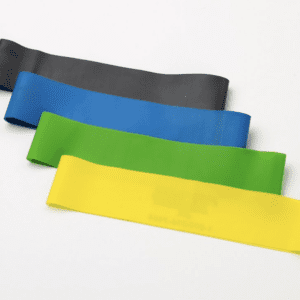Mini Band Work Out

Mini Bands
The mini band is an easy to use and portable tool for resistance and mobility training. For runners, activating muscles in different planes of motion can help resolve typical muscle imbalances. Working muscles and joints through full range of motion is also healthier than just relying on the mobility created from running alone.
Muscles that get dysfunctional or inhibited in runners are commonly found at the hip. Many stability muscles exist here and work to control hip motion throughout the stance phase of the stride. Although it may not look like it, there is rotation and side to side motion at the hip that needs to be coordinated, stable and strong.
The following exercises have been shown to activate and strengthen these hip muscle groups. Aim for doing one to three sets of 10-15 repetitions. There should be some feeling of fatigue. Focus on the muscles that should be working. Feeling the muscles work has been shown to be very helpful for improving recruitment. Bands come in different colours representing different resistances.
Keep in mind that just doing exercises may not necessarily recruit the right muscles. The body is pretty efficient at taking the easy way out. If a muscle is inhibited or weak, it may not automatically activate. Compensations are very common. If you are unsure about the effectiveness of these exercises, an assessment with one of our physiotherapists will help get you on track. We often have to address muscle tightness or compensatory patterns first, before a muscle will start activating again.
1. Clamshell
Purpose: lateral hip stability, hip range of motion
Muscles: gluteus medius and minimus
Common Compensating Muscles: hip flexors, quadriceps, hip adductors, foot investors, trunk
Key Points: Mini Band is above knees. Lay on your side with knees bent to 90 degrees and hips open 45 degrees from the waist. Shoulder, hip, and ankle should be in a line. Tip body forward slightly to prevent the body from rolling backward. Lift top knee up, keeping heels together and let toes come apart. Open hips as far as you can go without rotating backward. Hold 3-5 seconds, slowly lower the top leg. This can be quite difficult, so it is fine to start without the band and build it up.
2. Bridge
Purpose: Hip extension, hip range of motion
Muscles: Gluteus Maximus
Common Compensating Muscles: Hamstrings, back extensors, quadriceps
Key Points: Mini Band is above the knees. Hamstrings and quadriceps often want to take over for the gluteals, focus on the buttock muscles. Laying on your back, bend knees to 90 degrees or more. Place feet slightly wider than hips and push knees out into the band (this helps activate the gluteals). Lift hips up using the buttock muscles. Lift until the body is level from shoulder to knees. Hold 3-5 seconds and then lower. Bend knees in further or lift toes up to minimize overuse of quads or hamstrings.
3. Monster Walk
Purpose: Lateral hip stability
Muscles: Gluteus Medius and Minimus
Common Compensating Muscles: Hip flexors, quadriceps, hip adductors, foot invertors, trunk
Key Points: Mini band is at the ankles or around the feet. Stand with hands across the chest and feet hip width apart. Take small steps forward keeping hips wide. Keep trunk from twisting. Take 10-15 steps forward and then do the same walking backward. Rest between sets to let the muscle burn settle. This should be felt at the lateral hips and is generally felt more with the backward walk.
4. Standing Clock
Purpose: Balance; hip activation in multiple directions
Muscles: All hip muscles
Common Compensating Muscles: trunk, hip flexors
Key Points: Mini band around knees or ankles (harder). Stand tall on left leg and visualize that you are standing in the middle of a clock. Pull leg towards 2 o’clock, 4 o’clock and then 6 o’clock. Repeat 5-10 times and then do the mirror image on the other side. Repeat to feel fatigue in hips. Both standing and moving legs work in this exercise.
5. Squat
Purpose: hip, ankle and knee mobility; trunk stability, quadricep and buttock activation
Muscles: Many; good to focus on buttock
Key Points: Mini band above knees. If unable to lower into a 90-degree deep squat, try a heel lift or can use a ball behind the back and against the wall. Push knees out into band, feet hip width apart or wider. Lower hips to 90 degrees or lower. Use gluteals to straighten up again. Back should not bend more than 45 degrees forward as you squat.






